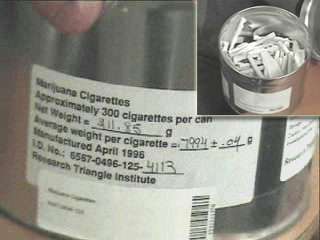Uncle Sam's Expanded Marijuana Menu
A new list of offerings suggests the government's cannabis monopoly is suddenly aiming to please.

Just as the fear of privatization spurred Pennsylvania's state-run liquor monopoly to act more like a profit-oriented business, talk of allowing competition with Uncle Sam's marijuana monopoly seems to have encouraged a more customer-oriented attitude at the National Institute on Drug Abuse, which is currently the country's only legal source of cannabis for research. NIDA's recently revised online menu of marijuana available to qualifying researchers suggests the agency is aiming to please in new ways. "NIDA appears to finally be loosening longtime restrictions on cannabis research," says Allen St. Pierre, executive director of the National Organization for the Reform of Marijuana Laws, "due to political pressure bubbling up from the states."
For years NIDA's marijuana monopoly, which is different from the approach the federal government takes with every other Schedule I drug, has been cited as a major barrier to studies of the plant's medical utility. The monopoly forces scientists who have met all other requirements to beg for research material from an agency whose raison d'etre is identifying all the bad things that happen to people when they use illegal drugs. Even when NIDA let medical researchers have some of its stash, the quality was mediocre and the selection meager.
A 2001 attempt to get the Drug Enforcement Administration's approval for a private source of marijuana, backed by the Multidisciplinary Association for Psychedelic Studies (MAPS), dragged on for a decade and ultimately failed, but it called attention to an issue that has since been taken up by members of Congress. The CARERS Act, a bipartisan bill introduced in both houses of Congress last month that would legalize medical marijuana in states that allow it, also would require the DEA to license three additional sources of marijuana for research. Even Senate Judiciary Committee Chairman Chuck Grassley (R-Iowa), an ardent prohibitionist who is not keen on the bill, seems inclined to support this aspect of it, saying the government should "lift any unnecessary barriers that may hinder responsible scientific research into the medical risks and benefits of potential marijuana-based medicines." St. Pierre notes that pressure for such reform is "emanating from frustrated parents seeking access to cannabinoid products for their sick children."
NIDA's list of "Marijuana Plant Material Available from the NIDA Drug Supply Program" suggests such criticism may be having an impact. "Research grade marijuana products are available in a variety of cannabinoid content specifications," the agency says. "NIDA may also be able to develop bulk marijuana of other specific THC and CBD contents by mixing batches to meet researcher needs." The menu lists dozens of different marijuana "batches," with THC content ranging from 0 percent (for placebos) to 12.4 percent, which NIDA calls "very high" but your average Colorado marijuana merchant would not. Medicine Man in Denver, for example, offers several strains with THC content above 20 percent.
Medicine Man's strain names are better too. Who would smoke Batch #1289A, for instance, when he could have Bubba Kush or Purple Dream?
Medicine Man also sells a wide variety of edibles and vaping products. NIDA has none of those. It does offer standardized government joints, but only while supplies last. That product line, familiar to the few patients who have received marijuana from the federal government under an "investigational new drug" program that was closed to new applicants in 1992, has been discontinued.
One area where NIDA seems to have an advantage: It advertises a couple dozen strains that are low in THC but high in cannabidiol (CBD), a nonpsychoactive compound that shows considerable medical promise, especially in treating drug-resistant epilepsy. That's a much bigger selection than you can find on Medicine Man's medical menu, and NIDA's CBD content is higher.
Even more striking, NIDA's prices are dirt cheap compared to Medicine Man's: $2.50 per gram, which is one-fifth what Medicine Man charges recreational customers for its least expensive strain. NIDA's customers do not have to pay Colorado's marijuana taxes, the agency has no retail markup, and its contractor's costs must be pretty low given the large scale of production and the absence of legal risk. But note that you get that bargain price only if you are a government-approved researcher and buy a kilogram at a time. Then again, if you are lucky enough to qualify for an NIH grant, you get all the pot you want for free, which is probably not a business model that will be emulated by private-sector marijuana merchants.
Addendum: MAPS Executive Director Rick Doblin, whose organization is developing a study of marijuana as a treatment for posttraumatic stress disorder, notes that high-CBD strains were not previously available from NIDA. "The change is part of the reduction in resistance to medical marijuana research due to the increasing number of medical marijuana and marijuana legalization states," Doblin says. But he adds that NIDA's marijuana can only get you so far if your aim is prescribable cannabis, since the Food and Drug Administration requires that Phase 3 studies of a proposed medicine use exactly the same product that the sponsor plans to market. Doblin says that means the process cannot be completed without a private source of marijuana.
Doblin calls NIDA's five-year, $68 million contract with Mahmoud ElSohly, the University of Mississippi pharmacy professor who produces the government's marijuana, "an expensive way to continue to block the marijuana plant from becoming an FDA-approved prescription medicine." But he adds that "it does facilitate academic research, which will also eventually undermine the resistance to ending the NIDA monopoly."



Show Comments (26)